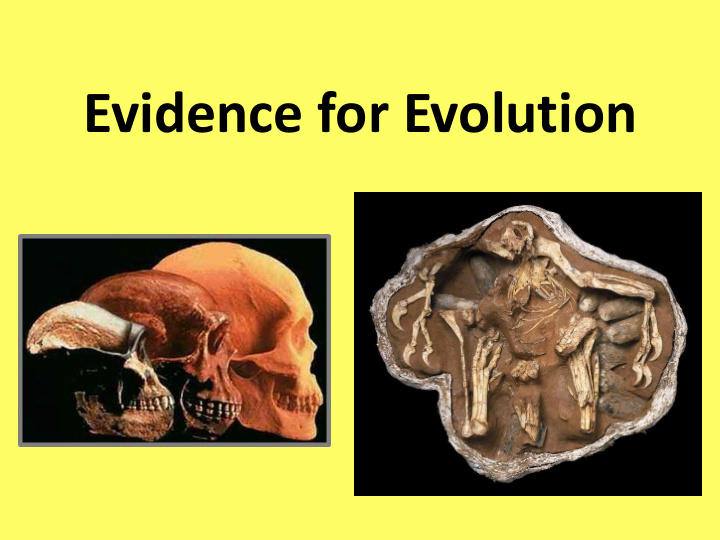



Evidence for Evolution
Scientific evidence of biological evolution uses information from geographical, geological, physical, chemical and mathematical applications. 1.A.4
Evidence of Biological Evolution • Geographic – Distribution of living things on Earth • Geological – Examples include fossils • Physical – Comparative Morphology/Embryology • Chemical – Comparison of DNA nucleotide and protein sequences • Mathematical – Radiometric Dating of Fossils or Molecular Clocks
Phylogenetics • Evidence is then used to determine evolutionary relationships between organisms and the evolutionary history of an organism (this is called phylogeny ) • Relationships and history are depicted in diagrams known as phylogenetic trees Tree of Life Web Project
Phylogenetic Tree
Geographic Evidence
Geographic Evidence • Distribution of living things around the globe provides information about the past history of living things and the surface of the Earth ( biogeography ) • Use biogeography to understand the evolution of a species
Evolution of the Camel Family
Madagascar’s Endemic Species • Click on the hyperlink above to read about the endemic species of Madagascar
Geological Evidence
Geological Evidence • Examples include fossils and iron oxides in rock • Earth core samples show environmental change over time
Geological Evidence (Fossils) • Fossils can be dated by a variety of methods that provide evidence for evolution • Provide a record of early life and evolutionary history • Physical evidence of an organism that lived long ago
Fossil Dating • Law of superposition – “relative” age of fossils
Fossil Dating • Determine the age of a fossil by finding the age of the rock where the fossil is found (513-512 mya)
Fossil Dating • Determine the absolute age of a fossil by looking at the rate of decay of isotopes (radiometric dating) • Carbon-14: half life of 5730 years • Uranium-238: half life of 4.56 billion years
Carbon Dating
Physical Evidence
Physical Evidence Physical evidence of evolution includes: • Comparative Anatomy 1. Morphological Homologies 2. Vestigial Structures 3. Analogous Structures • Comparative Embryology
Homologous Structures • Homologous structures are structural features that originated in a common ancestor • Similar in structure but may differ in function
Vestigial Structures • Vestigial structures are remnants of functional structures that were once useful in the ancestor of the modern day organism
Analogous Structures (Homoplasies) • Structures that shares a common function, but are not similar in structure • Demonstrates that species evolved independently of one another, not related • Result from convergent evolution
Comparative Embryology • Comparison of embryos and embryo development • Evidence of common ancestry
Chemical Evidence
Chemical Evidence • Biochemical and genetic similarities: DNA nucleotide and protein sequences • Show evidence for evolution and ancestry • Analyze notable genetic similarities or differences • All domains of life rely on the same genetic code ( this is evidence of common ancestry for ALL life )
DNA Sequence Alignment Species of Beetles
Universal Genetic Code
Mathematical Evidence
Mathematical Evidence • Molecular clocks use mutations to estimate evolutionary time (assume that genetic mutations occur at a constant rate) • Estimate divergence
Molecular and genetic evidence from extant and extinct organisms indicates that all organisms on Earth share a common ancestral origin of life. 1.D.2
Evidence for Relatedness of All Life • Structural and functional evidence supports the relatedness of all domains (Eukarya, Bacteria, Archaea
Structural and Functional Evidence • DNA and RNA are carriers of genetic information • Genetic code is shared by all modern living systems • Conservation of metabolic pathways
Conservation of Metabolic Pathways • Glycolysis is the MOST widespread metabolic pathway among Earth’s organisms • Suggests glycolysis evolved very early in life
Structural Evidence Supports the Relatedness of All Eukaryotes • Cytoskeleton • Membrane-bound organelles • Linear chromosomes • Endomembrane system (ER, Golgi, Nuclear envelope)
HOX Genes • Body plan genes in animals (common ancestry)
Populations of organisms continue to evolve. 1.C.3
How do we know that evolution has occurred in all species? • Geological record of Earth’s history through the study of fossils • If the Earth has changed over time, then the organisms which inhabit the Earth must have the ability to evolve or they will die
Evolution Continues to Occur • Mutations that cause chemical resistance: - resistance to antibiotics (super cool video) - resistance to pesticides and herbicides - resistance to chemotherapy drugs
Pesticide Resistance
Emergent Diseases • Mutations of existing viruses • Spread of existing viruses from other animals
Recommend
More recommend